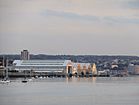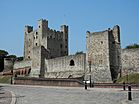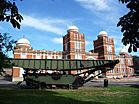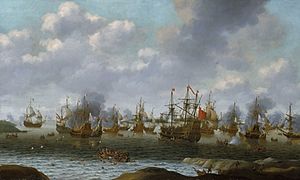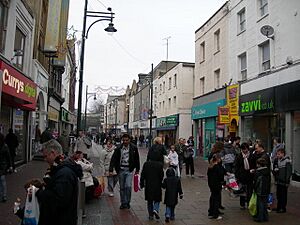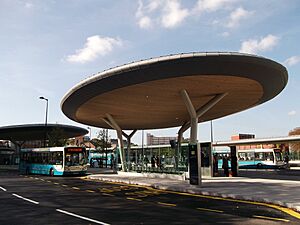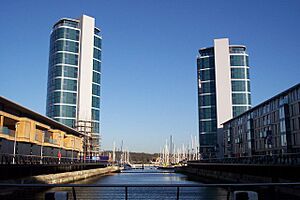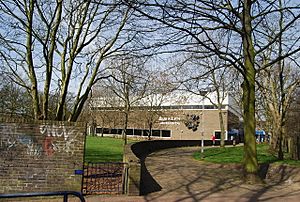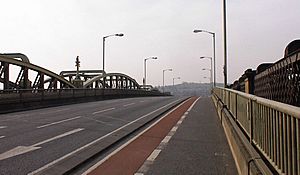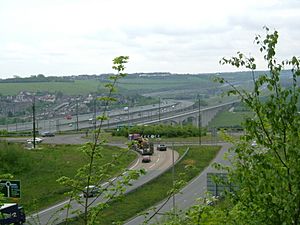Medway facts for kids
Quick facts for kids
Medway
|
|||
|---|---|---|---|
|
Unitary authority area and borough
|
|||
|
Clockwise from top: Rochester Cathedral, HMS Ocelot, Rochester Castle, Royal Engineers Museum, Upnor Castle, Chatham Historic Dockyard
|
|||
|
|||
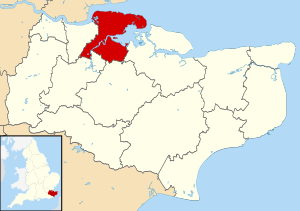
Shown within Kent
|
|||
| Sovereign state | United Kingdom | ||
| Constituent country | England | ||
| Region | South East England | ||
| Ceremonial county | Kent | ||
| Status | Unitary authority | ||
| Incorporated | 1 April 1998 | ||
| Admin HQ | Gun Wharf, Chatham | ||
| Government | |||
| • Type | Unitary authority | ||
| • Body | Medway Council | ||
| Area | |||
| • Total | 74.14 sq mi (192.03 km2) | ||
| Area rank | 170th (of 326) | ||
| Population
(2020)
|
|||
| • Total | 278,556 | ||
| • Rank | 52nd (of 326) | ||
| • Density | 3,757.00/sq mi (1,450.59/km2) | ||
| Ethnicity (2021) | |||
| • Ethnic groups |
List
|
||
| Religion (2021) | |||
| • Religion |
List
45.1% Christianity
43% no religion 5.5% not stated 2.7% Islam 1.6% Sikhism 1.1% Hinduism 0.6% other 0.4% Buddhism 0.1% Judaism |
||
| Time zone | UTC0 (GMT) | ||
| • Summer (DST) | UTC+1 (BST) | ||
| ONS code | 00LC (ONS) E06000035 (GSS) | ||
| OS grid reference | TQ768688 | ||
Medway is a special area in Kent, England. It's called a "unitary authority," which means its local government handles most things for the area, like a county council and a district council all in one. This makes it different from other parts of Kent.
Medway was created in 1998 by joining two older areas: Rochester-upon-Medway and Gillingham. In 2019, about 278,016 people lived here. The main towns in Medway are Chatham, Gillingham, Rainham, Rochester, and Strood. People often call these the "Medway Towns."
Medway is also part of a big development plan called Thames Gateway. It's home to Universities at Medway, where students can study at the University of Greenwich, the University of Kent, and Canterbury Christ Church University all on one campus.
Contents
- Exploring Medway's Geography
- Medway's Rich History
- Modern Medway: Growth and Development
- How Medway is Governed
- Education in Medway
- Medway's Population and Economy
- Culture and Fun in Medway
- Getting Around Medway
- Famous People from Medway
- Medway's Twin Towns
- Freedom of the Borough
- Images for kids
- See also
Exploring Medway's Geography
Medway is located by the River Medway, which has been important for thousands of years. The Romans built Watling Street here, a major road. Later, the Normans built Rochester Castle and Rochester Cathedral, which is the second oldest cathedral in Britain. The Chatham Dockyard was also built here, showing how important the area was for defence.
Towns and Villages in Medway
The main towns in Medway, from west to east, are Strood, Rochester, Chatham, Gillingham, and Rainham. Many other smaller towns and villages are also part of Medway, like Frindsbury and Brompton. Some villages, like Cuxton, Halling, and Wouldham, are in the Medway Gap area south of Rochester and Strood.
On the Hoo Peninsula to the north, you'll find villages such as Hoo St Werburgh, Cliffe, High Halstow, St Mary Hoo, Allhallows, Stoke, and Grain. The southern part of the urban area is on the side of the North Downs, with suburbs like Walderslade, Luton, Hempstead, and Wigmore.
Nature and Wetlands
More than half of Medway is countryside. It includes parts of the North Kent Marshes, which are important wetlands. These areas are home to many special plants and animals and are protected as Sites of Special Scientific Interest (SSSIs). Another special place is Ranscombe Farm, known for its rare woodland flowers and orchids growing on chalk grassland.
Medway's Rich History
The Medway area has a long and interesting history. It was first shaped by the city of Rochester, and later by the naval and military bases in Chatham and Gillingham.
Roman and Medieval Rochester
Rochester was built by the Romans on an Iron Age site. They called it Durobrivae, meaning "stronghold by the bridge," because it controlled where Watling Street crossed the River Medway. Rochester became a walled town, and a mint was set up there. The first cathedral was built in 604, and later rebuilt by Bishop Gundulf, who also built the castle you can still see today. Rochester was also a key stop for people traveling the Pilgrims' Way to Canterbury.
Today, you can still see parts of the Roman city wall in Rochester. There are many old buildings, like the Guildhall (now a museum), built in 1687, and the Corn Exchange from 1698. You can also see Watts Charity, a small Tudor house for "six poor travelers." Queen Elizabeth I even visited Satis House and Old Hall. Medway has 82 protected ancient sites, 832 listed buildings, and 22 conservation areas.

The Royal Navy opened a dockyard in Gillingham during the time of Henry VIII. It was called Chatham Dockyard, even though much of it was in Gillingham. This dockyard was very important for building and repairing ships. It closed in 1984, causing many people to lose their jobs.
The dockyard was protected by forts like Fort Amherst and Upnor Castle. Famous ships were built here, including HMS Victory, Admiral Lord Nelson's flagship at the Battle of Trafalgar. Sir Francis Drake learned to sail on the Medway, and Nelson started his Navy service here at age 12.
In 1667, the Dutch launched a surprise attack on the dockyard. Upnor Castle tried to defend it, but the Dutch managed to cause damage.
Another warship built at Chatham that still exists is HMS Unicorn, launched in 1824. It never saw active service and is now preserved in Dundee, Scotland.
Explosions at Sea
On November 25, 1914, the battleship HMS Bulwark exploded in the River Medway while taking on coal. This terrible accident killed 745 men and 51 officers. The explosion was so powerful it could be heard 20 miles away. It remains one of the worst explosions in British history in terms of lives lost.
Less than six months later, on May 27, 1915, another ship, the Princess Irene, exploded. It was a passenger liner turned minelayer for the war. This explosion killed 278 people, including many local workers. Investigations suggested that mines were being prepared too quickly by untrained staff.
The British Army also had barracks here, and the Royal Engineers have their headquarters in Gillingham. The Royal Marines also have a long connection with Chatham. A museum dedicated to the Royal Marines is near the dockyard at the Royal Engineers Museum.
Modern Medway: Growth and Development
After World War II, Medway grew southwards, with new areas like Walderslade and Hempstead being built. This growth was helped by the M2 motorway built in the 1960s.
Medway's population is expected to reach around 300,000 by 2028. The local council plans to invest over £1 billion in development over 20 years, starting from 2006. This includes creating thousands of new homes and jobs.
In 2019, the towns by population were Gillingham (around 85,000), Chatham (78,000), Strood (40,000), Rochester (30,000), and Rainham (25,000). More people are expected to move to Medway because housing is more affordable than in London, which is only 30 miles away.
In 2004, Medway Council announced a plan to redevelop seven miles of the Medway waterfront. This project aims to build 6,000 to 8,000 new homes and create 8,500 jobs.
Transport Improvements
Plans for transport included a new bridge, changing Chatham's road system, and improving bus and cycle routes. Chatham's ring road became a two-way system in 2006, and a new bus station opened in 2011.
New Housing and Commercial Areas
- Rochester Riverside: A large area of former industrial land is being turned into new homes, a primary school, hotels, and businesses.
- Chatham Centre and Waterfront: Many new projects are planned for Chatham, including road improvements and new buildings like The Quays, which will have two 20-story residential towers.
- Medway Gate: A big development in Strood, built in an old chalk pit, has added over 400 new homes since 2006.
- Strood Riverside: Plans include more homes, new leisure facilities, and better access to the train station and town centre.
- Temple Waterfront: This area in Strood plans for 600 homes and commercial spaces.
How Medway is Governed
For a long time, people wanted to join the Medway towns under one government. In 1903, the Borough of Gillingham was created, and Rainham was added to it in 1928.
In 1944, a committee was formed to discuss combining Chatham, Gillingham, and Rochester into one larger area. However, the towns couldn't agree on how to do it, and the plan fell apart.
Under a new law in 1972, on April 1, 1974, Rochester, Chatham, and part of Strood joined to form the Borough of Medway. Gillingham chose to stay separate. In 1979, the borough was renamed Rochester-upon-Medway, and in 1982, it was given "city status."
Creating the Modern Medway Borough
The Medway we know today was created on April 1, 1998. This happened as part of big changes to local government in the 1990s. A new area called 'Medway Towns' was formed, combining Rochester-upon-Medway and Gillingham. This new area became a "unitary authority," meaning its council handles both district and county council duties.
The new district was given "borough status," which means the head of the council can be called the "mayor." The first elections for the new council were in 1997. On April 1, 1998, the council officially changed the name from Medway Towns to just Medway.
Because the old Rochester-upon-Medway district was abolished, it lost its city status. Medway Council tried to get city status in 2000, 2002, and 2012, but was not successful.
Education in Medway
Medway has a "two-tier" education system. This means that to get into some secondary schools, students take an exam called the Eleven plus exam. There are several grammar schools in the area, which are selective. Other secondary schools are non-selective. Medway also has many private schools. It has one of the largest populations of children who are home-schooled in the UK.
Medway's Population and Economy
| Top 10 countries of birth in 2011 | |
|---|---|
| Country of birth | Population |
| 236,589 | |
| 3,812 | |
| 1,731 | |
| 1,725 | |
| 1,542 | |
| 1,527 | |
| 743 | |
| 737 | |
| 692 | |
| 601 | |
- Population: In 2001, Medway had 249,488 people, with slightly more females than males. Most people lived in Chatham (70,540) and Gillingham (99,773).
- Jobs: When Chatham Dockyard closed, about 20,000 jobs were lost. In 2005, 2.3% of the workforce was unemployed. Many people who live in Medway now work outside the area, especially in London, because it's easy to travel there.
Culture and Fun in Medway
Medway has a group called Creative Medway that helps develop the area's culture, bringing together businesses, cultural groups, and artists.
Theatres and Entertainment
There are five theatres in Medway. The Central Theatre and the Brook Theatre are run by the council. The Medway Little Theatre, The Oasthouse Theatre, and Kings Theatre are independent.
Sports and Recreation
- Medway Park in Gillingham is a large sports centre. It has three indoor pools for swimming and SCUBA diving, a gym, and courts for various sports. It was updated for the Medway 2012 program, linked to the London Olympics.
- The Strand Leisure Park in Gillingham has an outdoor swimming pool right by the River Medway, plus tennis courts and a small railway.
- Strood Sports Centre has an indoor pool, gym, and sports hall.
- The Ice Bowl in Gillingham is an ice rink, home to the Invicta Dynamos ice hockey team.
- Gillingham F.C. is the main football team in the area. They play in Football League Two.
- John Nike Ski Centre is a ski slope located near Hempstead.
- Splashes Leisure Centre in Rainham has a swimming pool with an indoor slide and a wave machine.
- Medway Dragons Rugby League Football Club plays rugby at local sports facilities.
Getting Around Medway
Roads and Motorways
The A2, an old Roman road called Watling Street, runs through Medway. It connects the Port of Dover to London. To ease traffic, the M2 was built in the 1960s to bypass the Medway Towns.
Other important roads include:
- A226: Connects Medway to Gravesend.
- A228: Runs along the west bank of the Medway, through Strood, and up to the Isle of Grain. A new dual carriageway was built to improve this road.
- A229: Starts in Rochester and heads south to Maidstone and the M20.
- A278 Hoath Way: Links the A2 in Gillingham to its southern suburbs and the M2.
- A289 Medway Towns Northern Relief Road: Built in the 1990s to bypass Strood and connect to the Medway Tunnel.
Buses and Coaches
Most local bus routes in Medway start from the Waterfront bus station in Chatham. Arriva Southern Counties runs most services. Other companies also provide routes, including some for schools.
You can also catch coaches to London and other parts of the South East. National Express runs services to Gatwick Airport.
Train Travel
Medway has seven train stations:
- Strood Station
- Rochester Station
- Chatham Station
- Gillingham Station
- Rainham Station
- Halling Station
- Cuxton Station
The area is served by the Medway Valley line, the North Kent line, and the Chatham Main Line. The first railway lines came to Medway when half of the Thames and Medway Canal tunnel was turned into a railway.
Over time, different railway companies built lines, and eventually, they merged. Train services were electrified, making travel faster. In 2015, a new Rochester station opened.
The High Speed 1 line also passes through Medway. This line offers fast train services to Stratford International and St Pancras International in London, which is very popular for people commuting to the city.
Waterways and Air Travel
The River Medway is mainly used for leisure, but cargo ships still use it to deliver goods to cement works and the port. Thamesport, on the Isle of Grain, handles containers and fuels.
For air travel, there are two small airports: Rochester Airport for leisure, and Stoke Airfield for microlights. For bigger flights, most Medway residents use the main London airports.
Famous People from Medway
Many interesting people have connections to Medway:
- William Adams: The first Englishman to reach Japan. He was born in Gillingham and became a samurai warrior. This led to Medway twinning with Japanese cities Yokosuka and Itō.
- Charles Dickens: The famous author lived in Medway. There used to be a museum about him in Rochester.
- Thomas Aveling: He invented the steamroller and is buried in Hoo St. Werburgh.
- Kelly Brook: Actress and model, born in Rochester.
- Jools Holland: Musician and TV host, lives in Cooling Castle on the Hoo Peninsula.
- River Medway: A contestant on RuPaul's Drag Race UK Series 3.
Medway's Twin Towns
Medway is twinned with several towns around the world, which means they have a special friendship and cultural exchange:
 — Valenciennes (France)
— Valenciennes (France) — Yokosuka and Itō (Japan)
— Yokosuka and Itō (Japan) — Cádiz (Spain)
— Cádiz (Spain) — Foshan (China)
— Foshan (China)
Freedom of the Borough
The "Freedom of the Borough" is a special honor given to military units or organizations for their service to Medway.
Military Units
- The Royal Corps of Engineers: 2008
- HMS Chatham, RN: 2011
- "C" Company 3rd Battalion The Princess of Wales's Royal Regiment: 2018
- The Royal Marines
Organizations and Groups
- The Royal Naval Association (Chatham Branch): 2022
- The Chatham Historic Dockyard Trust: 2022
- The Medway NHS Foundation Trust: 2023
Images for kids
See also
 In Spanish: Medway para niños
In Spanish: Medway para niños




